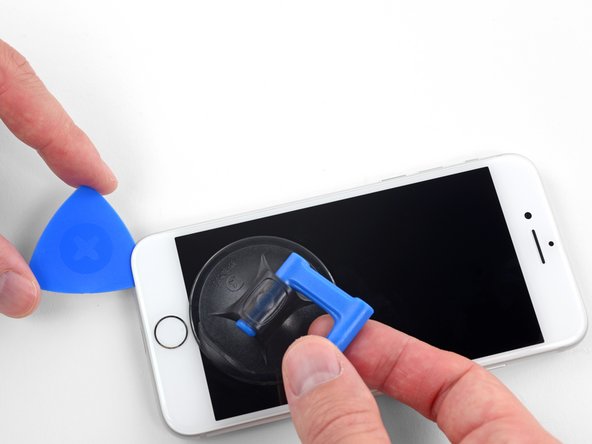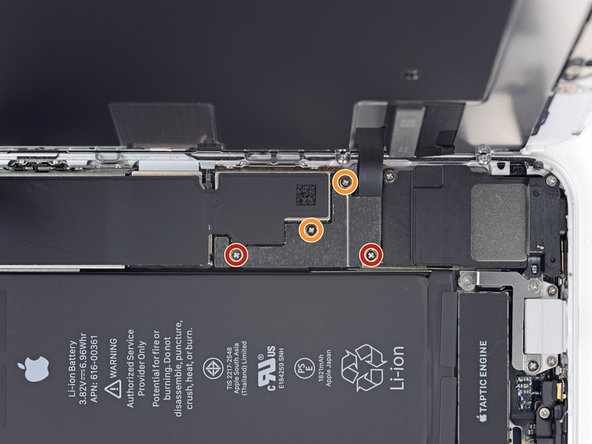Esta versão pode conter edições incorretas. Mude para o último instantâneo verificado.
O que você precisa
-
-
Remova os dois parafusos pentalobe de 3,5 mm na borda inferior do iPhone.
-
-
-
Meça 3 mm a partir da ponta e marque a palheta com um marcador permanente.
-
-
Este passo não foi traduzido. Ajude a traduzi-lo
-
If your display glass is cracked, keep further breakage contained and prevent bodily harm during your repair by taping over the glass.
-
Lay overlapping strips of clear packing tape over the iPhone's display until the whole face is covered.
-
If the broken glass makes it difficult to get a suction cup to stick in the next few steps, try folding a strong piece of tape (such as duct tape) into a handle and lifting the display with that instead.
-
-
-
Puxe a pega azul para trás para destravar os braços do Anti-Clamp.
-
Deslize os braços pela borda esquerda ou direita do seu iPhone.
-
Posicione as ventosas próximo à borda inferior do iPhone, diretamente acima do botão home - uma pela dianteira e a outra pela traseira.
-
Aperte as ventosas uma contra a outra para aplicar sucção na área desejada.
-
-
-
Puxe a pega azul para a frente para travar os braços.
-
Gire a pega 360 graus no sentido horário até que as ventosas comecem a se esticar.
-
Certifique-se de que as ventosas permaneçam alinhadas uma com a outra. Se elas começarem a ficar desalinhadas, solte um pouco as ventosas e realinhe os braços.
-
-
-
Aqueça uma bolsa térmica iOpener e passe-a pelos braços do Anti-Clamp.
-
Dobre a bolsa térmica iOpener de modo que ela fique sobre a borda inferior do iPhone.
-
Aguarde um minuto para que o adesivo tenha a chance de se soltar e apresentar um vão para a abertura.
-
Insira uma palheta de abertura no vão.
-
Pule as próximas três etapas.
-
-
-
O aquecimento da borda inferior do iPhone ajudará a amolecer o adesivo que prende a tela, facilitando a abertura.
-
Use um secador de cabelo ou prepare uma bolsa térmica iOpener e aplique-o(a) na borda inferior do iPhone por cerca de 90 segundos para amolecer o adesivo que se encontra por baixo.
-
-
-
Aplique uma ventosa de sucção na metade inferior do painel dianteiro, imediatamente acima do botão home.
-
-
-
Este passo não foi traduzido. Ajude a traduzi-lo
-
Remove four Phillips screws securing the lower display cable bracket to the logic board, of the following lengths:
-
Two 1.3 mm screws
-
Two 2.8 mm screws
-
Remove the bracket.
-
-
Este passo não foi traduzido. Ajude a traduzi-lo
-
Use the point of a spudger to pry the battery connector out of its socket in the logic board.
-
Bend the battery connector cable slightly away from the logic board to prevent it from accidentally making contact with the socket and providing power to the phone during your repair.
-
-
Este passo não foi traduzido. Ajude a traduzi-lo
-
Use the point of a spudger to pry the lower display connector out of its socket.
-
-
Este passo não foi traduzido. Ajude a traduzi-lo
-
Use the point of a spudger to disconnect the second lower display cable.
-
-
Este passo não foi traduzido. Ajude a traduzi-lo
-
Remove the three 1.3 mm Phillips screws securing the bracket over the front panel sensor assembly connector.
-
Remove the bracket.
-
-
Este passo não foi traduzido. Ajude a traduzi-lo
-
Use the point of a spudger to disconnect the front panel sensor assembly connector.
-
-
Este passo não foi traduzido. Ajude a traduzi-lo
-
Remove the four Y000 screws securing the bracket over the home/Touch ID sensor:
-
One 1.2 mm screw
-
Three 1.3 mm screws
-
Remove the bracket.
-
-
Este passo não foi traduzido. Ajude a traduzi-lo
-
Use an opening tool to pry under the left edge of the home button cable connector to disconnect it from its socket.
-
-
Este passo não foi traduzido. Ajude a traduzi-lo
-
Flip the display assembly over. Use a hairdryer or prepare an iOpener and apply it to the lower edge of the display for about 90 seconds in order to soften up the adhesive underneath.
-
-
Este passo não foi traduzido. Ajude a traduzi-lo
-
Use an opening pick to gently separate the adhesive holding the home/Touch ID sensor cable to the back side of the display panel.
-
-
Este passo não foi traduzido. Ajude a traduzi-lo
-
Remove the home/Touch ID sensor assembly by lifting it through the front side of the display.
-
-
Este passo não foi traduzido. Ajude a traduzi-lo
-
Remove the three Phillips screws securing the top earpiece bracket to the front panel:
-
Two 2.6 mm screws
-
One 1.8 mm screw
-
-
Este passo não foi traduzido. Ajude a traduzi-lo
-
Lift the front facing camera up out of its socket and swing it out of the way.
-
-
Este passo não foi traduzido. Ajude a traduzi-lo
-
Remove the two Phillips screws securing the earpiece speaker to the front panel:
-
One 1.8 mm screw
-
One 2.3 mm screw
-
-
Este passo não foi traduzido. Ajude a traduzi-lo
-
Heat an iOpener and apply it to the upper edge of the display to soften the adhesive holding the front camera and sensor assembly in place.
-
-
Este passo não foi traduzido. Ajude a traduzi-lo
-
Use the point of a spudger to gently pry the proximity sensor out of its recess on the front panel.
-
-
Este passo não foi traduzido. Ajude a traduzi-lo
-
Slide the tip of a spudger underneath the ambient light sensor flex cable, and lift the sensor out of its housing.
-
-
Este passo não foi traduzido. Ajude a traduzi-lo
-
Slide an opening pick underneath front camera cable assembly, separating the adhesive holding the camera and sensor cable.
-
-
Este passo não foi traduzido. Ajude a traduzi-lo
-
Remove the three 1.2 mm Y000 screws from either side of the display for a total of six screws.
-
-
Este passo não foi traduzido. Ajude a traduzi-lo
-
Heat an iOpener and lay it over the edge of the shield closest to the home button to soften the adhesive holding it in place.
-
-
Este passo não foi traduzido. Ajude a traduzi-lo
-
Use an opening pick to break up the adhesive near the home button that holds the flat display cable to the LCD shield plate.
-
-
Este passo não foi traduzido. Ajude a traduzi-lo
-
Insert an opening pick from the bottom right corner and continue to separate the display cable from the LCD shield plate.
-
-
Este passo não foi traduzido. Ajude a traduzi-lo
-
Gently lift the LCD shield plate from the display assembly.
-
Cancelar: não concluí este guia.
79 outras pessoas executaram este guia.
17 comentários
So I’m pretty sure I know the answer to this - but can I test out the screen replacement without hooking up the camera, home button, etc? Can I just attach the three cables to the phone to make sure the screen works, or would it brick the phone?
Hi Sarah,
You can test the display without bricking your phone. It may boot-loop when the front sensor/camera assembly isn’t connected though. Be careful while you work with an opened phone with the battery connected…it is easy to accidentally short things out!
After replacing the iPhone 8 LCD Screen and Digitizer, it seems that the battery is draining faster. I just wanted to see if this is a normal problem or was there something I missed during the install process?
My daughters phone was repaired and the same thing is happening to her
Do you have to remove the plastic holder for the camera?


























































































